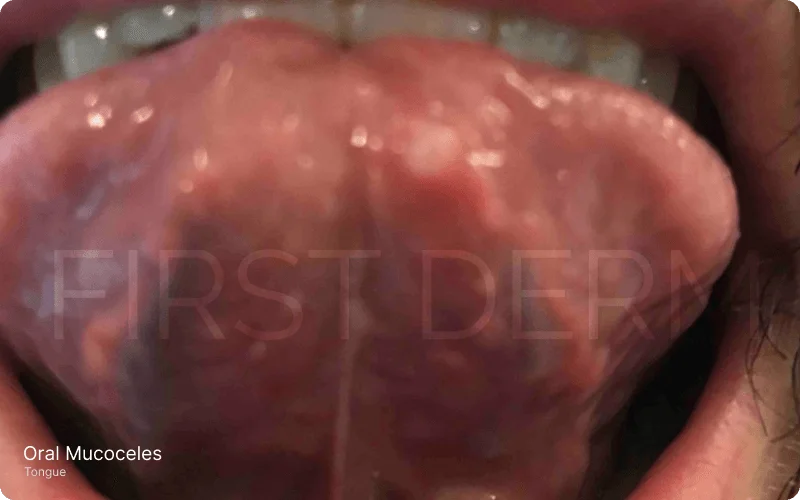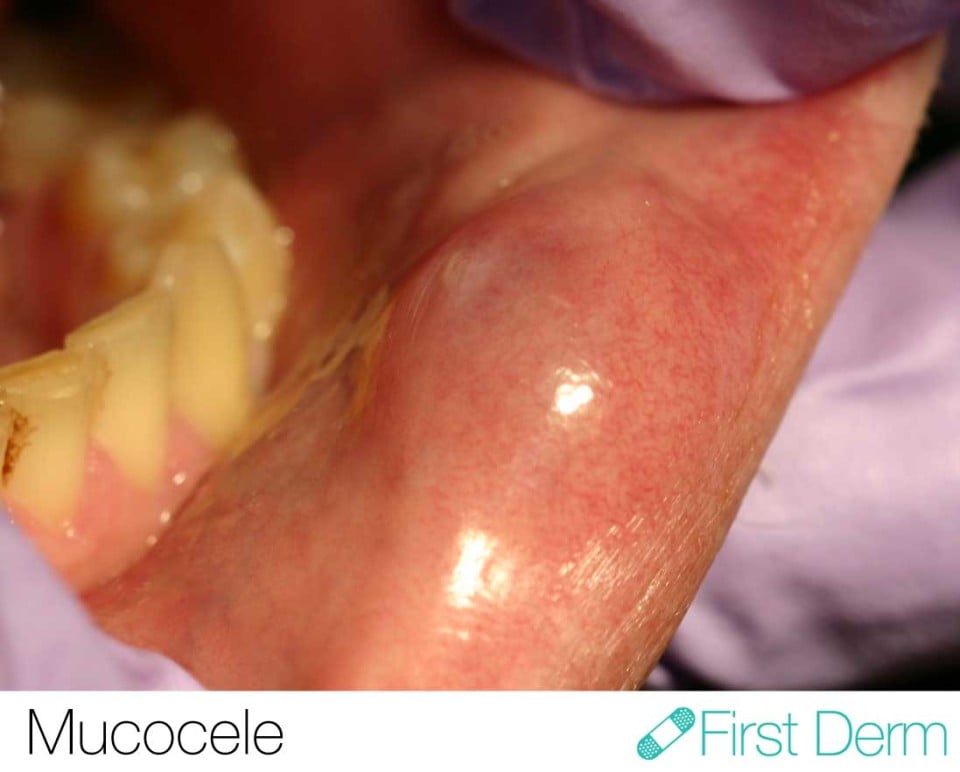Oral Mucocele
Medically reviewed by The Dermatologists and written by Dr. Alexander Börve
Common
- Requires medical diagnosis
- Symptoms: Small, soft, fluid-filled cysts, dome-shaped lesion
- Color: Typically red, whitish or transculent
- Location: Around the lips, gums, tongue, and roof of the mouth
- Treatment: No treatment necessary; surgery
Oral Mucoceles are painless swellings around or in the mouth. They are usually caused by excessively biting or sucking the cheek or lower lip. However, the cause is unknown in most cases.
This damages the salivary ducts, emitting a buildup of mucus and creating the cysts. Some medications can cause saliva to thicken, increasing the risk of clogged salivary glands and mucoceles. If the growth changes color when you put pressure on it, the cyst may be a hemangioma – a growth of blood vessels.
Symptoms and Causes
Symptoms of Oral Mucoceles
A mucocele usually appears inside or around the lips, gums, tongue, and roof of the mouth. It presents as a dome-shaped lesion and can occur spontaneously.
These cysts are small, soft, and filled with mucous. Most of the time, the lesion is translucent, but it can sometimes be blue. Deeper lesions can have a whitish coloration while bleeding into the swelling can cause a bright red appearance. They are typically painless, but when they can burst, they emit a clear fluid.
Most mucoceles are less than 1 cm in diameter but range from 0.1-4 cm in size. The duration of the lesion is usually 3-6 weeks; however, it may vary from a few days to several years in exceptional instances.
While most are painless, larger ones can cause discomfort if they interfere with speech, chewing, or swallowing.
The Blandin and Nuhn mucocele occurs exclusively at the midline of the tongue. It is similar to mucocele in other areas but is caused by repeated trauma against the lower teeth.
What causes Oral Mucoceles
Oral Mucoceles form mainly due to trauma, commonly from accidental biting or sucking of the cheek or lower lip. They might also be the result of blocked or damaged salivary glands.
Factors contributing to mucoceles include:
- Lip-biting or lip-sucking habits.
- Chronic inflammation from smoking or tobacco use.
- Thickened or damaged salivary ducts.
- Trauma from medical procedures like intubation.
Real-Life Experience with Oral Mucocele

Recurring fluid-filled bump on the tongue, often indicative of Oral Mucoceles, causing intermittent discomfort
User’s question:
This little pimple-looking bump on my tongue flares up every once in a while it fills up with fluid and then pops. Sometimes it completely heals and goes away for a little while. sometimes it doesn’t heal right away then pops over and over before it completely heals and goes away. It hasn’t gotten bigger but does cause some discomfort. I’ve read that I shouldn’t be concerned… is this true and what could it possibly be?
Online Dermatologists’ answer
Thank you for your inquiry. Based on the information and images of your tongue provided, this is possibly a mucocele or mucous cyst. Oral Mucoceles are painless swellings around or in the mouth. The cause is unknown in most cases. A mucocele usually appears inside or around the lips, gums, tongue, and roof of the mouth. It appears as a dome-shaped lesion and can occur spontaneously. These cysts are small, soft, and filled with mucous. Most of the time, the lesion is translucent, but it can sometimes be blue. Deeper lesions can have a whitish coloration while bleeding into the swelling can cause a bright red appearance. They are typically painless, but when they can burst, they emit a clear fluid. Most mucoceles are less than 1 cm in diameter but range from 0.1-4 cm in size. Warm salt-water rinses may help speed up the healing process. Thrusting the lesion with your tongue can worsen the condition. They can resolve spontaneously but may need surgery. As this is recurring and not resolving I advise you to see a dermatologist or oral medicine physician to perform an assessment, confirm the diagnosis, and rule out other conditions including early cancerous lesions.
Diagnosis and Tests
Diagnosis Procedures for Oral Mucoceles
To diagnose an oral mucocele, your healthcare provider primarily relies on your detailed symptom description and a thorough physical examination. This examination typically involves assessing the size, location, consistency, and color of the cyst or lesion.
While a visual inspection often suffices, in some cases, additional diagnostic tests may be necessary, especially if there’s any doubt regarding the nature of the lesion. These tests can include:
Ultrasound: This non-invasive imaging technique utilizes high-frequency sound waves to generate detailed images of the soft tissues inside the mouth. It can help determine the size, depth, and nature (solid or fluid-filled) of the mucocele.
Biopsy: A biopsy involves removing a small sample of the tissue from the lesion for microscopic examination. This procedure helps in confirming the diagnosis, ensuring it’s a benign mucocele and not another type of growth or lesion.
CT Scan: Typically reserved for rare cases, a CT scan may be employed if there’s suspicion that a ranula (a specific type of mucocele found on the floor of the mouth) has extended deeper into the neck region. The scan provides detailed cross-sectional images, offering a clear view of the lesion and its surroundings.
Management And Treatment
While many mucoceles tend to resolve on their own, particularly in infants and young children, it’s essential to monitor their progression. Avoid attempting home remedies or self-treatment as these can lead to infections or damage the surrounding oral tissues.
Medical Treatment Options for Oral Mucoceles
For those who experience recurrent mucoceles or have particularly large ones, there are several medical treatments available:
Cryotherapy: This involves the use of extreme cold to freeze and subsequently destroy the mucocele.
Laser Treatment: A specialized laser is employed to effectively remove the lesion without causing significant damage to the surrounding tissue.
Surgical Excision: In more severe cases or when other treatments might not be as effective, an oral surgeon or dentist can perform a procedure to surgically remove the mucocele. In certain instances, they may also opt to remove the associated salivary gland to prevent recurrence.
Post-Treatment Recovery
After undergoing any of these treatments, the recovery period can vary. Most healthcare providers advise patients to:
- Follow a liquid or soft diet for several days post-treatment, especially after undergoing cryotherapy or laser procedures.
- Extend the restricted diet for a longer period if surgical excision is the chosen method.
Additionally, engaging in rigorous physical activities or strenuous exercises is generally not recommended in the initial recovery phase, which can last from a few days to several weeks based on the procedure’s intensity.
Potential for Recurrence and Follow-ups for Oral Mucoceles
Oral mucoceles, even after being treated, can sometimes reappear. This recurrence underlines the importance of regular monitoring, especially after undergoing a treatment procedure. Periodic follow-ups with healthcare providers, especially in younger patients, are recommended. This not only helps in the early detection of any new or reappearing mucocele but also ensures the overall health of the oral cavity.
What can I do?
It’s essential to occasionally check the cyst to ensure it does not become infected or increase in size. Warm salt-water rinses may assist in accelerating the healing process. Thrusting or poking at the lesion with your tongue can exacerbate the condition.
When to Consult a Healthcare Professional?
It’s recommended to consult a doctor for any cyst or lesion that develops in or around your mouth. This will ensure that you receive a correct and timely diagnosis.
While many mucoceles resolve on their own, it’s prudent to be cautious. If you’re confident that your lesion is a mucocele, immediate treatment might not be necessary. However, if the mucocele persists for an extended period or causes discomfort, it’s essential to seek advice from a healthcare provider.
Source
- Flaitz CM, Burgess JD. Mucocele: Clinical features, diagnosis, and management. Emedicine.medscape.com. Updated Jun 22, 2023. Accessed Jul 7, 2023. https://emedicine.medscape.com/article/1076717-clinical#b4
- Chaitanya P, Praveen D, Reddy M. Mucocele on Lower Lip: A Case Series. Indian Dermatol Online J. 2017;8(3):205-207. doi:10.4103/idoj.IDOJ_151_16
- Huzaifa M, Soni A. Mucocele and Ranula. In: StatPearls [Internet]. Treasure Island (FL): StatPearls Publishing; 2023. Updated July 24, 2023. Available from: https://www.ncbi.nlm.nih.gov/books/NBK560855/
Ask a Dermatologist
Anonymous, fast and secure!

The Specialist doctor from the University Hospital in Gothenburg, alumnus UC Berkeley. My doctoral dissertation is about Digital Health and I have published 5 scientific articles in teledermatology and artificial intelligence and others.


